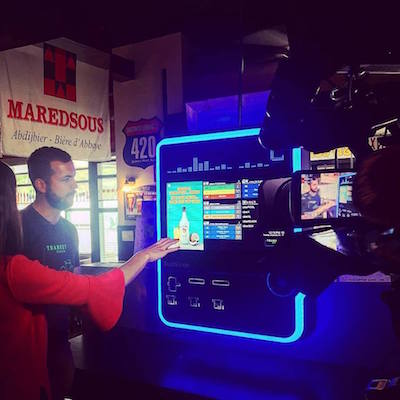In this series, WeWork’s director of digital community selects a WeWork member to get to know better, sharing her fun findings with the rest of the community.
As someone who has never owned a car, I was excited to learn about WeWork Times Square member company TransitScreen, which is making it easier for people to find transportation options nearby through connected screens with up-to-date information. Below, co-founder Ryan Croft tells me all about the company’s new music-based partnership, gondolas as public transit, and more.
What inspired you to create TransitScreen?
We came from a government program in Virginia called the Mobility Lab. My co-founder is a brain scientist with a Ph.D. in neuroscience and artificial intelligence engineering. My background is in enterprise software, and I had a travel company for a few years, leading trips all over the world: yoga retreats, wine tastings, scuba diving trips. So I traveled quite a bit in Latin America and the Caribbean, as well as Europe.
I was in the process of pivoting that company when I met my co-founder Matt. The idea had been incubated for a year with a government grant in the Mobility Lab at Arlington, and we decided to commercialize it. This was in 2013. The genesis was: how do you make information more readily available and digital in cities that are growing? Particularly as ways to get around cities proliferate. Bike-share, car-share, and mass transit—all of this is converging. There’s no one place to see all this information. So that’s where TransitScreen came from.

At what point did you realize you could build a company?
That was the biggest question early on. There was an NPR spot in D.C., early on in 2013, asking about how it’s a great idea, but how do you make money? So we realized that owners of real estate and corporations would pay for this service. Apps are out there, but there is no place for a B2B software for real estate. So TransitScreen makes sense—if you are building a $90 million building, the value is because of its location. So how do you convey the ability to get to different places and what it’s close to? The best way is to use a screen in the lobby, showing nearby places, bike shares, car shares, Uber, and more.
What kind of culture do you and your company embody? Does anyone drive to work? Or strictly public transit, walking, or biking?
We did a survey. 100 percent of our employees walk, take a bike, mass transit, or bike-share. 100 percent. It’s never been a question in any interviews we’ve done for employees, but when we looked at our data, we saw that we attracted the type of people that want to improve their city and get cars off the road by promoting these alternatives.
You recently announced a partnership with TouchTunes. How did that begin and why were you so excited to make it happen?
With this new partnership, there are 75,000 jukeboxes in the TouchTunes network nationally. We started incorporating TransitScreen into their digital jukebox interface with a few hundred units, and the program will be expanding out to thousands of units nationally through next year, so not only can you request some great music, but you can also find out how to get home from that bar or restaurant through mass transit, Uber, or Lyft.
The value proposition is so clear for people: when you’re at a bar, you don’t necessarily know your options for getting home. There’s a convenience factor of using TransitScreen while you’re at a location. There’s also a safety factor of waiting in a bar or restaurant to meet your train, bus, or other transportation option. And it’s a great sponsor option—we’re working with Pernod Ricard, and they want people to consume responsibly, so this helps boost their corporate social responsibility.

What inspires and motivates you during the tough times?
Cities are urbanizing, and a pain point for everyone is their commute. We all wish we had more time—so we are trying to give people their time back so they aren’t waiting for a bus or a train. Our biggest motivators are saving people time and making cities more livable.
Anything else we should know about you?
I’ve been to 60 countries and speak fluent Spanish. I’m an advanced scuba diver, and my wife says I’m a pretty good cook! Out of all 60 countries, I’d say London or Singapore has the best public transit options.
What’s the most interesting public transit option you’ve ever seen?
There’s a spine of the city in Medellín, Colombia, where the subways run, and at the central hub, you can take an urban gondola called metrocable up the side of the hill and over the entire city. The most amazing way to see a city is through a gondola, and it’s wildly popular.




